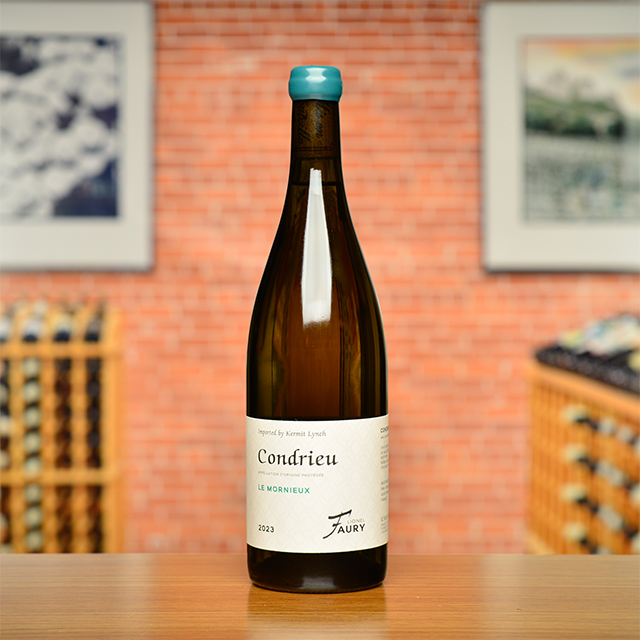Notify me
2017 Côte-Rôtie “La Dorée”
Barruol Lynch
The magic of great Côte Rôtie does not come from its reputation for being a big, bombastic wine. In fact, what you’re looking for is a balance of the wild, meaty, earthy, and floral characteristics. Do not be fooled. Syrah with restraint gives the most depth, complexity, and aging potential. This one is beautiful now with some decanting, and it will continue to satisfy well into the future.
—Clark Z. Terry
| Wine Type: | red |
| Vintage: | 2017 |
| Bottle Size: | 750mL |
| Blend: | Syrah |
| Appellation: | Côte Rôtie |
| Country: | France |
| Region: | Northern Rhône |
| Producer: | Barruol / Lynch |
| Winemaker: | Louis Barruol |
| Vineyard: | 30 - 50 years |
| Soil: | Schist |
| Farming: | Lutte Raisonnée |
| Alcohol: | 13% |
More from this Producer or Region

2020 Hermitage Rouge “La Pierrelle”
France | Northern Rhône
Elegance and restraint from one of the hill’s lesser-known terroirs.

2021 Côte-Rôtie “Besset”
France | Northern Rhône
From the classic aromas of graphite, black fruit, and roasted spice, to the total finesse of its tannins, this is Côte-Rôtie at its best.

2022 Côte-Rôtie “La Boisselée”
France | Northern Rhône
Made from six vineyards that, when blended, showcase the whole of the Côte Rôtie appellation.

2021 Hermitage Rouge “La Pierrelle”
France | Northern Rhône
A thick perfume of dry-aged meat, smoke, and violets preface a wine that is powerful, but in perfect proportion.

2022 Saint Joseph Rouge “La Gloriette Vieilles Vignes”
France | Northern Rhône
Made from vines planted between 1937 and 1976, this cuvée showcases impressive depth and soul.

2023 Condrieu
France | Northern Rhône
I would say that Faury does not make Viognier, but rather one hell of a Condrieu, replete with huge apricot and peach aromas and a fresh, regal palate.

2021 Côte-Rôtie “Les Roses”
France | Northern Rhône
Delicate and perfumed, it speaks softly, yet it has so much to say: lilies, bacon fat, spices... it could only be Côte Rôtie.

2020 Hermitage Blanc “La Pierrelle”
France | Northern Rhône
From vines that are more than eighty years old comes this Marsanne with magnificent floral, pit fruit, and bitter notes.

2020 Côte-Rôtie “Fongeant”
France | Northern Rhône
This cuvée is sourced exclusively from the Fongeant lieu-dit, which sits right on the border of the Côte Blonde and Côte Brune, and is renowned for sharing the best of both.

2022 Crozes Hermitage “Habrard”
France | Northern Rhône
Delicate floral aromas will blossom, and your first glass will be spring-loaded with a palate-invigorating freshness and velvety depth.
About The Producer
Barruol / Lynch
Louis Barruol is an indefatigable force in the Rhône, the 14th generation in his family to be making wine in Gigondas. On what was once the site of a Roman villa, Louis’ cellars show spectacular remains of Roman vinification vats carved into the limestone. Here, Louis works with different grape varietals from the Rhône, vinifying each parcel separately. He’s taken to acting as a micro-négociant, working with top growers in the region who still work with Sérine. Producing only a few precious barrels of each cuvée, Louis is helping to save the authenticity and identity of old Côte Rôtie parcels. Together, he and Kermit blend our Northern Rhône wines and a Southern Côtes du Rhône Blanc and Rouge from a selection of Louis’ purchases.
More from Northern Rhône or France
2023 Collines Rhodaniennes Syrah “l’Art Zélé”
Lionel Faury France | Northern Rhône
2020 Côte-Rôtie “Fongeant”
Barruol / Lynch France | Northern Rhône
2023 Saint-Joseph Blanc “Clef de Sol”
Domaine Jolivet France | Northern Rhône
2020 Hermitage Rouge “La Pierrelle”
Barruol / Lynch France | Northern Rhône
2023 Condrieu
André Perret France | Northern Rhône
2021 Côte-Rôtie “Les 3 Brunes”
Lionel Faury France | Northern Rhône
2022 Crozes Hermitage “Habrard”
Barruol / Lynch France | Northern Rhône
2021 Saint-Joseph Rouge “L’Instinct”
Domaine Jolivet France | Northern Rhône
2023 Saint-Péray Blanc
Domaine Clape France | Northern Rhône
2020 Hermitage Blanc “La Pierrelle”
Barruol / Lynch France | Northern Rhône
2021 Côte-Rôtie “Besset”
Barruol / Lynch France | Northern Rhône
2023 Crozes-Hermitage Rouge
Domaine Jean-Claude Marsanne France | Northern Rhône
2023 Collines Rhodaniennes Syrah “l’Art Zélé”
Lionel Faury France | Northern Rhône
2020 Côte-Rôtie “Fongeant”
Barruol / Lynch France | Northern Rhône
2023 Saint-Joseph Blanc “Clef de Sol”
Domaine Jolivet France | Northern Rhône
2020 Hermitage Rouge “La Pierrelle”
Barruol / Lynch France | Northern Rhône
2023 Condrieu
André Perret France | Northern Rhône
2021 Côte-Rôtie “Les 3 Brunes”
Lionel Faury France | Northern Rhône
2022 Crozes Hermitage “Habrard”
Barruol / Lynch France | Northern Rhône
2021 Saint-Joseph Rouge “L’Instinct”
Domaine Jolivet France | Northern Rhône
2023 Saint-Péray Blanc
Domaine Clape France | Northern Rhône
2020 Hermitage Blanc “La Pierrelle”
Barruol / Lynch France | Northern Rhône
2021 Côte-Rôtie “Besset”
Barruol / Lynch France | Northern Rhône
2023 Crozes-Hermitage Rouge
Domaine Jean-Claude Marsanne France | Northern Rhône
Kermit once said...

Kermit once said...
If you're looking for value, look where no one else is looking.
Inspiring Thirst, page 211
















